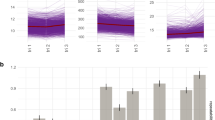Abstract
Objective
To examine whether changes in nucleated erythrocyte (nRBC) counts in the early neonatal period can distinguish between causes of nRBC release.
Methods
From a data set of 465 nonanomalous singleton live births delivered at 22–32 weeks, excluding maternal diabetes mellitus, Rh isoimmunization, and chronic hypertension, 125 cases had a complete blood count with an nRBC count within 3 hours of life and at least one other value obtained within 48 hours of the first. The change in nRBC count per deciliter was calculated (ΔnRBC) and was correlated with antenatal fetal assessment, neonatal outcome variables, and placental histopathology infwe categories: 1) histologic acute intrauterine inflammation, 2) uteroplacental vascular lesions, 3) intraplacental vaso-occlusive lesions, 4) chronic inflammation, and 5) coagulation-related lesions.
Results
There were 92 cases (74%) of premature rupture of membranes (PROM) and preterm labor/intact membranes (PTL) and 33 cases (26%) of preeclampsia. In PROM/PTL, multivariate analyses demonstrated that a higher uteroplacental vascular lesion score was related to more stable nRBC counts (P =.009), whereas a higher nonmyeloid count in the initial neonatal white blood cell count was related to a more rapid decrease in ΔnRBC (combined r = 0.54, P <.0001). No features were related to ΔnRBC in preeclampsia.
Conclusion
In PROM/PTL, but not in preeclampsia, patterns of change in the nRBC count in the early newborn period vary with uteroplacental vascular lesions and acute inflammation. This may reflect differences in the mediators of nRBC release (erythropoietin versus cytokines) and in disease acuity, (J Soc Gynecol Invest 1997;4:178–182) Copyright © 1997 by the Society for Gynecologic Investigation.
Similar content being viewed by others
References
Phelan JP, Ahn MO, Korst LM, Martin GI. Nucleated red blood cells: A marker for fetal asphyxia? Am J Obstet Gynecol 1995;173:1380–4.
Naeye RL, Localio AR. Determining the time before birth when ischemia and hypoxemia initiated cerebral palsy. Obstet Gynecol 1995;86:713–9.
Ulich TR, del Castillo J, Guo K. In vivo hematologic effects of recombinant interleukin-6 on hematopoiesis and circulating numbers of RBCs and WBCs. Blood 1989;73:108–10.
Erslev AJ, Gabunda TG. Erythrocytes. In: Pathophysiology of blood. Philadelphia: WB Saunders, 1985:40.
Salafia CM, Pezzullo JC, Lopez-Zeno JA, Minior VK, Simmens S, Vintzileos AM. Placental pathology of preterm preeclampsia. Am J Obstet Gynecol 1995;173:1097–105.
Salafia CM, Weigl C, Silberman L. The prevalence and distribution of acute placental inflammation in uncomplicated term pregnancies. Obstet Gynecol 1989;73:383–9.
Brosens I, Dixon HG, Robertson WB. Fetal growth retardation and the arteries of the placental bed. Br J Obstet Gynaecol 1977;84:656–63.
Robertson WB, Khong TY, Brosens I, et al. The placental bed biopsy: Review from three European centers. Am J Obstet Gynecol 1986;55:401–12.
Khong TY, Pearce JM, Robertson WB. Acute atherosis in pre-eclampsia: Maternal determinants and fetal outcome in the presence of the lesion. Am J Obstet Gynecol 1987;157:360–3.
Dommisse J, Tiltman AJ. Placental bed biopsies in placental abruption. Br J Obstet Gynaecol 1992;99:651–4.
Salafia CM, Lopez-Zeno JA, Sherer DM, Whittington SS, Minior VK, Vintzileos AM. Histologic evidence of old intrauterine bleeding is more frequent in prematurity. Am J Obstet Gynecol 1995;173:1065–70.
Brosens I, Renaer M. On the pathogenesis of placental infarcts in preeclampsia. J Obstet Gynaecol Br Commonw 1972;79:794–9.
Fox H. Effect of hypoxia on trophoblast in organ culture. Am J Obstet Gynecol 1970;107:1057–64.
Lowell DM, Kaplan C, Salafia CM. College of American Pathologists Conference XIX on the Examination of the Placenta: Report of the working group on the definition of structural changes associated with abnormal function in the maternal/fetal/ placental unit in the second and third trimester. Arch Pathol Lab Med 1991;115:647–731.
Perrin EVDK. Placenta as a reflection of maternal diseases. In: Bennington JL, ed. Pathology of the placenta. Philadelphia: WB Saunders, 1978:73–76.
Stevens NG, Sander CH. Placental hemorrhagic endovasculitis: Risk factors and impact on pregnancy outcome. Int J Gynaecol Obstet 1984;22:393–7.
Labarrere CA, Catoggio LJ, Mullen EG, Althabe OH. Placental lesions in maternal autoimmune diseases. Am J Reprod Immunol Microbiol 1986;12:78–86.
Erlendsson K, Steinsson K, Johannsson JH, Geirsson RT. Relation of antiphospholipid antibody and placental bed inflammatory vascular changes to the outcome of pregnancy in successive pregnancies of 2 women with systemic lupus erythematosus. J Rheumatol 1993;20:1779–85.
Redline RW, Abramowsky CR. Clinical and pathological aspects of recurrent placental villitis. Hum Pathol 1985;16:727–31.
Altshuler G, Russell P. The human placental villitides: A review of chronic intrauterine infection. Curr Top Pathol 1975;60:64–112.
Salafia CM, Ghidini A, Pezzullo JC, Rosenkrantz TS. Early neonatal nucleated erythrocyte counts in preterm deliveries: Clinical and pathological correlations. J Soc Gynecol Invest 1997;4:138–143.
Ulich TR, del Castillo J, Yin S, Egne JC. The erythropoietic effects of interleukin 6 and erythropoietin in vivo. Exp Hematol 1991;19:29–34.
Abbas AK, Lichtman AH, Pober JS. Cytokines. In: Cellular and molecular immunology. Philadelphia: WB Saunders, 1994:247.
Author information
Authors and Affiliations
Rights and permissions
About this article
Cite this article
Salafia, C.M., Ghidini, A., Pezzullo, J.C. et al. Patterns of Change in Early Neonatal Nucleated Erythrocyte Counts in Preterm Deliveries. Reprod. Sci. 4, 178–182 (1997). https://doi.org/10.1177/107155769700400402
Published:
Issue Date:
DOI: https://doi.org/10.1177/107155769700400402




